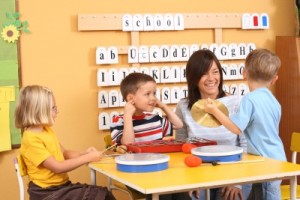Intentional Learning Supports
Posted by PLB Administrator Assistant · 2 Comments

 Learning is something that happens all the time and there are no greater learners than the children among us. It is for this very reason that we must be intentional in our selection of learning supports and strategies in the classroom.
Learning is something that happens all the time and there are no greater learners than the children among us. It is for this very reason that we must be intentional in our selection of learning supports and strategies in the classroom.
Quite simply, we wouldn’t buy a car without taking it for a test drive. Similarly, when we plan a menu for a special dinner, we don’t just pop the first thing we find in the fridge into a pot. A lot of us are quite intentional about what we wear, what we say or who we befriend.
It should be the same with learning. We should act with intention about what we present from the moment each student enters our classroom. What is placed on the bulletin board, the organization (or mess) in the classroom, the first thing we ask in the morning, etc all play an important role in the learning process. There really are no “non-learning” times when we are with students. At every moment, students are learning something- either positive, or negative. Let’s make what they learn during the time with us, that which we intend.
Teachers spend much time and effort planning and implementing lesson plans. As we do so, let’s also consider what students learn from our classroom environment. For example, are the bulletin boards decorative items or a learning tool? Take a moment and think about the unintentional learning that happens in classrooms.
What are ways that teachers can ensure that every part of the classroom learning experience is intentional?




As an elementary school teacher, I have always INTENTIONALLY planned lessons that are integrated and meaningful for students. I never see Language Arts, Social Studies and Science as separate curriculum areas. The informative and fiction books students should read in class should relate to the social studies or science curriculum. Morning Meetings – Morning Messages and Greetings should incorporate the curriculum that students are learning. Project based learning activities synthesize what students have learning. This can be done with technology, as there are so many sites for students to exhibit their culminating knowledge. For three weeks I have been teaching fifth grade social studies and literacy. Since the students are learning about the Republican government the Romans originated, doesn’t it make sense to see what part of the Republican government still stands today? I intentionally created a presidential candidate debate chart so students could record what each candidate said for the “common good.” This was not a written lesson plan in the text book the students are using. I intentionally created a connection that is meaningful to the lives of the students. I showed snippets from YouTube of the first Obama and Romney presidential debate. We had a lively discussion. As the students changed classes, they were talking about the debate intelligently, and not just reiterating what their parents tell them. All weekend I planned a Constitution unit. Students will choose several amendments and several of the Bill of Rights to examine and explain in a magazine they will write with non-fiction text features. They will choose a quote from that time in history and explain what it means. They will choose four fascinating facts about the Constitution and include them in the magazine. I chose a few movies from the internet that explain Article II, treaties, and the checks and balances that exist in our government. Students need to see visuals to make hard text accessible. Without INTENTION on the part of the teacher, students see each curriculum area as separate from themselves, lacking meaning. It is every teachers’ obligation to plan with intention. This is the ‘art” of teaching!
Thanks for the always insightful comments Marcy!